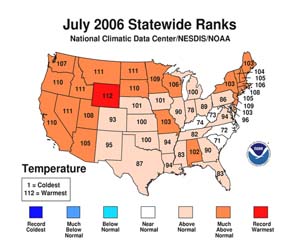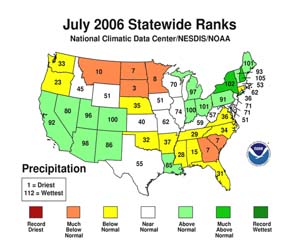| NOAA Magazine || NOAA Home Page |
U.S.
HAS ITS SECOND-HOTTEST JULY ON RECORD;
DROUGHT CONDITIONS WORSEN
 August
7, 2006 � The continental United States suffered through its second-hottest
July on record because of a blistering heat wave from California
to Washington, D.C. The heat wave broke more than 2,300
daily temperature records for the month and eclipsed more than 50
records for the highest temperatures in any July, according to the NOAA
National Climatic Data Center in Asheville, N.C. The hottest July
on record occurred in 1936, and the third hottest was 1934. (Click
NOAA image for larger view of July 2006 statewide temperature rankings.
Please credit “NOAA.”)
August
7, 2006 � The continental United States suffered through its second-hottest
July on record because of a blistering heat wave from California
to Washington, D.C. The heat wave broke more than 2,300
daily temperature records for the month and eclipsed more than 50
records for the highest temperatures in any July, according to the NOAA
National Climatic Data Center in Asheville, N.C. The hottest July
on record occurred in 1936, and the third hottest was 1934. (Click
NOAA image for larger view of July 2006 statewide temperature rankings.
Please credit “NOAA.”)
The agency also reported that the first seven months of 2006 was the warmest January-July of any year the United States since records began in 1895. And, the scorching temperatures, combined with a shortage of rainfall, expanded moderate-to-extreme drought conditions in areas already hard hit.
U.S.
Temperature Highlights
The average July 2006 temperature for the contiguous United States (based
on preliminary data) was 77.2 degrees F (25.1 C). More than 90 records
for the highest night-time temperatures for July were broken. The average
January - July 2006 temperature was 55.3 degrees F (12.9 C), which beat
the previous record set in 1934.
The Residential Energy Demand Temperature Index (REDTI), which provides information related to climate sensitive residential energy demand, ranked as the fourth highest July index in the 112-year record. Using this index, NOAA scientists determined that the nation’s residential energy demand was approximately 22 percent higher than that which would have occurred under average climate conditions for the month.
The average July temperature (based on the statistical mean from 1901 - 2000) is 74.3 degrees F. The July 1936 record temperature was 77.5 degrees F. The July 1934 average temperature (third highest on record) was 77.1 degrees F. The previous January - July cumulative record temperature was 54.8 degrees F (set in 1934).
NOAA scientists
add that no single episode of extreme heat can be blamed exclusively
on human-induced global warming, but instead heat waves will become
more likely and progressively more intense over the course of decades.
Changes in the frequency and intensity of heat waves across North America
will be comprehensively assessed in the forthcoming Climate
Change Synthesis and Assessment Product 3.3.
 U.S.
Precipitation Highlights
U.S.
Precipitation Highlights
The average precipitation for July 2006 across the continental United
States was 0.18 inch (4.6 mm) below the 20th century average, contributing
to a January-July period that was 22nd driest on record. (Click
NOAA image for larger view of July 2006 statewide precipitation rankings.
Please credit “NOAA.”)
In July, 51 percent of the United States, mostly in the Plains states and Southeast, was in moderate-to-extreme drought (based on the Palmer Drought Index), an increase of five percent from June. This percentage ranks with the biggest droughts of the last 50 years. The most extensive drought occurred in July 1934 when 80 percent of the country was affected by moderate-to-extreme drought. In addition, 28 percent of the country, mainly in the Plains states, was in severe-to-extreme drought in July, up from 27 percent in June.
In 2007, NOAA, an agency of the U.S. Commerce Department, celebrates 200 years of science and service to the nation. From the establishment of the U.S. Coast and Geodetic Survey in 1807 by Thomas Jefferson to the formation of the Weather Bureau and the Bureau of Commercial Fisheries in the 1870s, much of America's scientific heritage is rooted in NOAA.
NOAA is dedicated to enhancing economic security and national safety through the prediction and research of weather and climate-related events and information service delivery for transportation, and by providing environmental stewardship of the nation's coastal and marine resources. Through the emerging Global Earth Observation System of Systems (GEOSS), NOAA is working with its federal partners and more than 60 countries to develop a global monitoring network that is as integrated as the planet it observes.
Relevant Web Sites
NOAA
National Climate Summary: July 2006
Selected U.S. City and State Extremes for July 2006
NOAA National Climatic Data Center
Media
Contact:
John Leslie, NOAA
Satellite and Information Service, (301) 713-1265